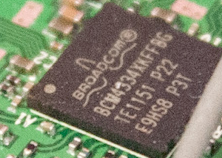9to5Mac reports to have ‘discovered’ a Broadcom chip inside one of the prototypes of the next iPhone. The write-up specifically menions Broadcom’s BCM4334 unit, basically a single-chip, dual-band silicon that supports 802.11n WiFi networking, Bluetooth 4.0+HS and an integrated FM radio receiver.
A successor to Broadcom’s BCM4330 – itself fabbed on the 65-nanometer process and found inside the iPad 3 and iPhone 4S – the newer BCM4334 unit is built on the 40-nanometer process, resulting in significant power savings.
As a result of using this chip in the next iPhone, Apple should be able to mitigate power drain stemming from the bigger screen and LTE radios while making a thinner device overall. That’s just the beginning. Read on…
Piggy-backing on a report by The Next Web’s Matthew Panzarino from ten days ago, editor Seth Weintraub claimed in a 9to5Mac article that Apple will use dual-band WiFi chip to enable direct peer-to-peer file transfers between next-gen iOS devices and certain Mac models.
The author first points to a handy description of the Broadcom BCM4330 unit over at Anandtech that mentions power reduction in the range of 40-50 percent and “dramatically reduced standby power by 3 orders of magnitude”. For example, the older BCM4330 in full Rx mode consumes around 68mA, while its successor the BCM4334 consumes 36mA at the same voltage.
Anandtech also mentions this important feature:
The combo device also features advanced switching techniques that enable concurrent dual-band operation to simultaneously support network connectivity with one band while also allowing content streaming via technologies such as Wi-Fi Display and Wi-Fi Direct.
Weintraub then concludes:
The new iPhone will be the first iOS device that meets that Apple standard for AirDrop and therefore we could easily see the Lion adhoc file sharing protocol added to iOS 6.
As you know, it’s currently possible to synchronize your iOS device wirelessly with desktop iTunes, but ad hoc file transfer is not possible. As a result, it’s not possible to use Image Capture on the Mac to export camera roll images when iTunes Wi-Fi sync is enabled unless your device is connected to a computer via a USB cable.
You also cannot copy files via iTunes File Sharing unless the device is physically connected to your computer.
Dual-band WiFi capability solves these issues in one fell swoop.
It certainly gives Apple a reason to bump the Wifi chip up to this more expensive dual mode version that was just announced in late February. Wifi Direct is also used in more and more printers as well, but its main purpose is making wireless file sharing extremely easy, as Google does in its Galaxy Nexus devices.
OS X Lion has a feature called AirDrop for ad hoc wireless file transfers between Macs equipped with dual-band Wi-Fi cards.
Theoretically speaking, with the dual-band Broadcom BCM4334 making its way inside the next iPhone, Apple could easily enable AirDrop file transfers between next-generation iOS devices and Macs:
With Apple’s easy-to-understand interface, an iOS AirDrop feature could make sharing between Macs and iOS devices and between iOS devices (or dare we say to Android devices?) beyond simple.
Here’s an overview of AirDrop in OS X Lion (mark 2:54).
[tube]tq2enQYTrbU[/tube]
So, with this in mind, we’ll finally be able to cut the cord forever and not only sync wirelessly with iTunes, but also beam files, copy camera roll images and more to the Mac, all over the air.
If this is in the cards, a dedicated iOS app to handle documents storage and file transfers would be needed.
Files.app, anyone?

